Ever wondered how to transform your bedroom into a peaceful sanctuary that effortlessly blends simplicity with sophistication? Japandi style, a perfect fusion of Japanese minimalism and Scandinavian coziness, has taken the design world by storm—and for good reason. Known for its calming aesthetic, clean lines, and warm natural textures, Japandi bedrooms create an environment that promotes relaxation and mental clarity, making them a popular choice for those seeking balance in a busy world.
In this article, you’ll discover a wealth of inspiring ideas and practical tips to help you achieve that serene Japandi vibe in your own space. From minimalist furniture and neutral color palettes to subtle decorative touches and clever storage solutions, we’ll explore a variety of design elements that emphasize calm and harmony. Get ready to reimagine your bedroom with fresh inspiration and thoughtful details that will turn your space into a true retreat.
1. Minimalist Bed Frames with Clean Lines for Serenity
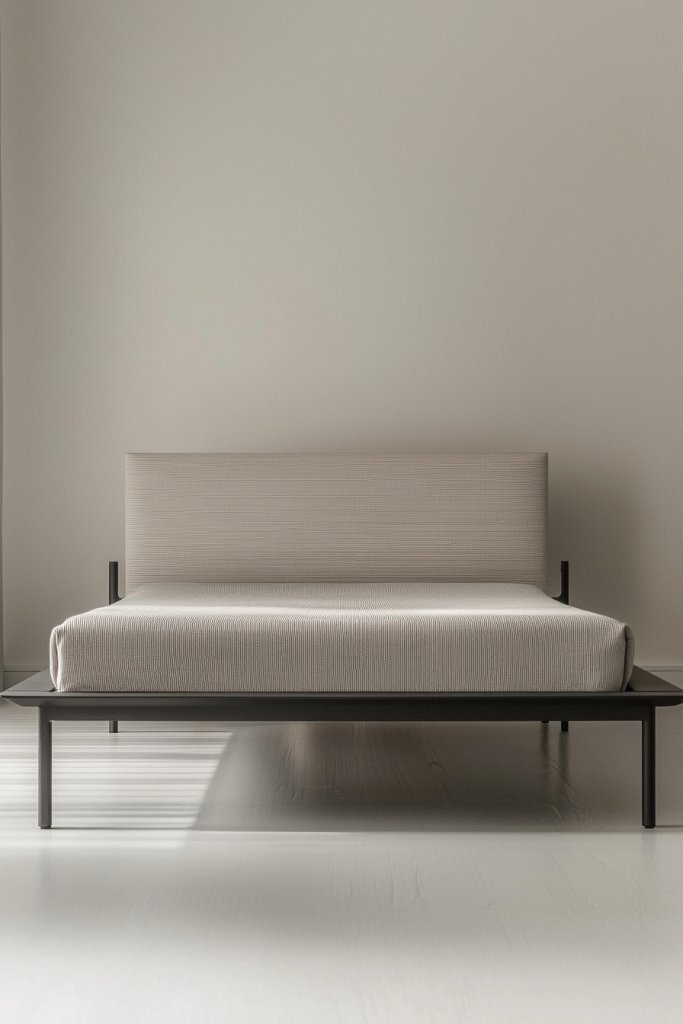
A minimalist bed frame with clean, sleek lines instantly sets a tranquil tone in a Japandi-inspired bedroom, cultivating a sense of calm and order that helps you unwind. It’s the perfect foundation for a space that combines serenity with understated elegance, making your retreat feel both spacious and restful.
Imagine a low-profile platform bed crafted from warm, natural wood with smooth, unembellished surfaces. The frame features simple, straight lines without ornate details, allowing it to blend seamlessly with soft, neutral bedding—think a crisp white duvet topped with a cozy beige throw blanket with chunky knit texture.
The bed is flanked by uncluttered nightstands with minimalist silhouettes, and the entire space exudes a sense of grounded simplicity. The natural wood tones complement muted shades of taupe, soft greys, and creamy whites, creating a calming atmosphere that invites relaxation.
The textures are tactile and soothing, from the matte finish of the wood to the gentle touch of the bedding and soft rugs, enhancing the overall sense of serenity. To recreate this look, start with a low-profile wooden bed frame made from light oak, walnut, or bamboo—materials that emphasize warmth and natural beauty.
Pair it with neutral-colored bedding in cotton or linen for breathable comfort. You can find affordable, stylish frames at furniture stores or online retailers, or consider building a simple DIY version if you’re handy.
Keep your nightstands minimal with sleek designs—think open shelves or smooth surfaces—using materials like wood, ceramic, or matte metal. Finish the look with a soft, textured rug underneath and add subtle decorative accents such as ceramic vases or sculptural lamps to complete the serene, clutter-free aesthetic.
2. Neutral Color Palettes to Create a Tranquil Atmosphere
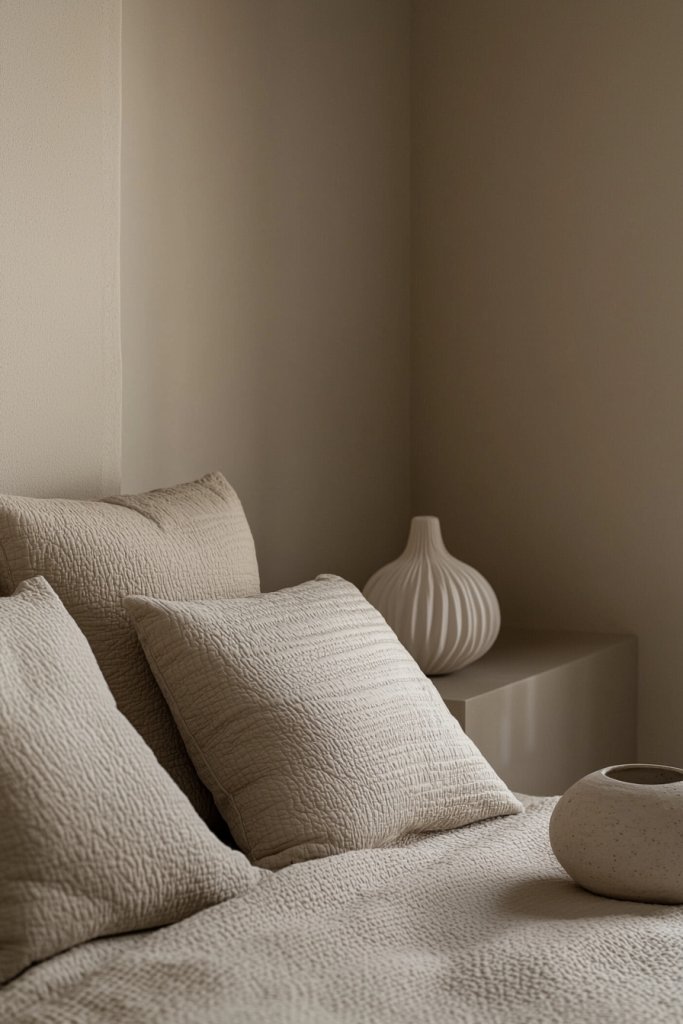
Creating a neutral color palette is the perfect way to set a calming, balanced tone in your Japandi bedroom—transforming it into a serene retreat from everyday chaos. By embracing subtle, monochromatic tones, you craft a space that feels harmonious and effortlessly elegant, inviting relaxation at every turn.
Imagine a room painted in soft shades of warm beige, light taupe, or gentle greys, complemented by furniture in natural wood finishes and plush textiles in matching muted hues. The bedding features a crisp, white linen sheet set layered with a cozy, cream-colored throw blanket with chunky knit texture, adding tactile warmth.
Textured ceramics in matte finishes and simple woven baskets sit neatly on open shelves, creating visual interest without clutter. The overall atmosphere exudes tranquility, with a quiet glow from soft, diffused lighting that invites you to unwind and breathe deeply.
To bring this calming palette to life, start by choosing a neutral wall color like warm beige or light grey. Opt for furniture with natural wood tones—think light oak or ash—that complement the soft textiles and ceramics.
Incorporate plush bedding in shades of white, cream, or sand, and add textured accessories such as woven baskets or ceramic vases. Keep your space clutter-free by using sleek, simple storage solutions and layering textiles gently for warmth. With just a few thoughtfully selected pieces, you can create a peaceful, harmonious bedroom that exudes quiet sophistication.
3. Low-Profile Platform Beds for a Grounded Feel
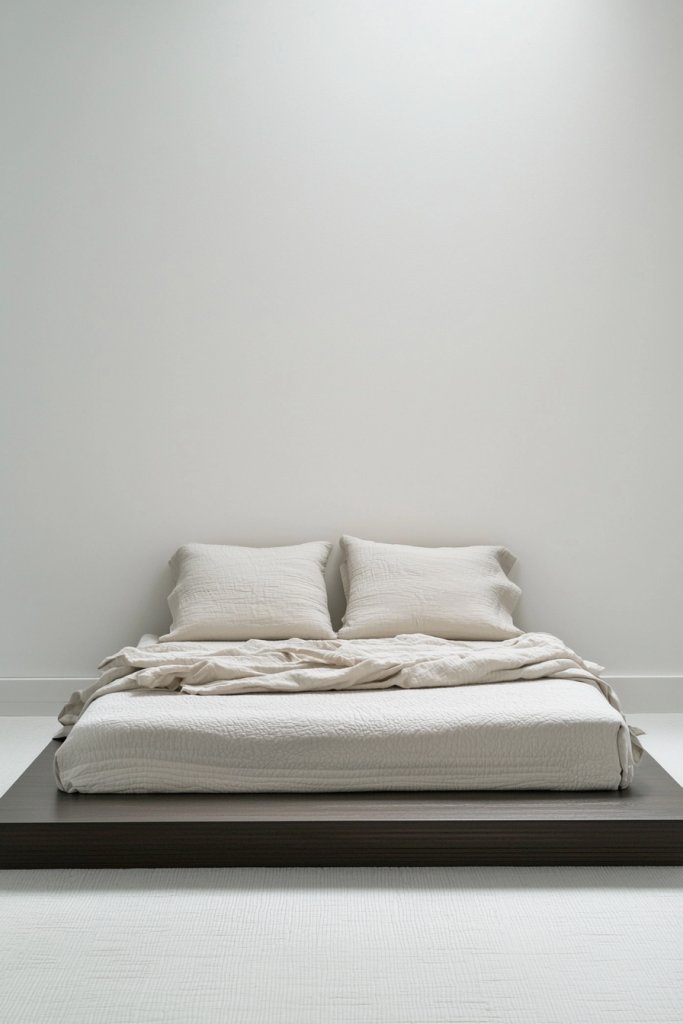
A low-profile platform bed instantly grounds your bedroom with its sleek silhouette and minimalist charm, embodying the calm and balanced aesthetic of Japandi design. Its unobtrusive presence creates an open, airy feel that invites tranquility and simplicity into your space.
Imagine a bed sitting just a few inches above the floor, crafted from warm, natural wood with a smooth, matte finish. The mattress rests directly on a sturdy, flat platform, accented by crisp, white or soft beige bedding that drapes effortlessly over the edges.
Surrounding the bed, the neutral palette is complemented by textured textiles like a chunky-knit throw or a woven cotton blanket, adding tactile warmth. The overall look exudes a sense of grounded serenity, with clean lines and understated elegance that make the room feel both spacious and cozy.
To recreate this look, start with a low-profile platform bed frame made of light or dark wood—these can often be found ready-made or DIY options. Pair it with simple, neutral bedding in linen or cotton and add a textured throw blanket for extra comfort.
You can also enhance the aesthetic with minimalist bedside tables or floating shelves, which require just a few basic tools and materials like wood planks or brackets. Assembling the bed is straightforward, and with a little effort, you’ll achieve that serene, grounded Japandi vibe that feels both modern and timeless.
4. Natural Wood Finish Furniture for Warmth and Simplicity
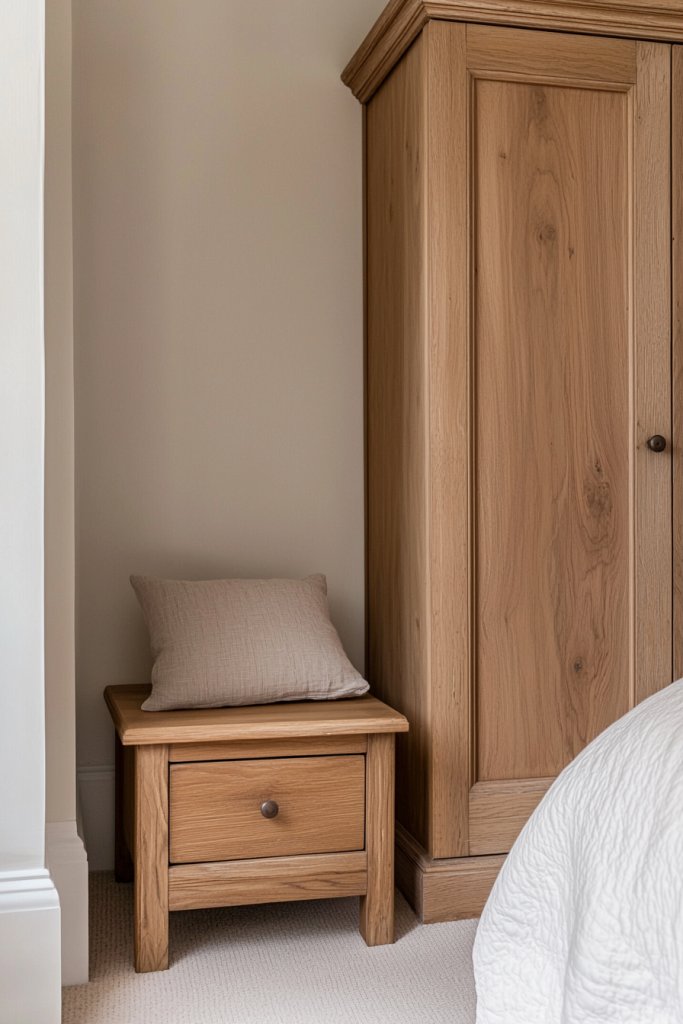
Natural wood finish furniture is the cornerstone of creating a warm and inviting Japandi bedroom, blending simplicity with organic beauty. It instantly adds a touch of nature and tranquility, making your space feel both cozy and effortless.
Imagine a sleek bed frame crafted from smooth, light oak or ash wood, showcasing the natural grain and subtle knots that highlight its handcrafted charm. Complement this with matching nightstands and a low-profile dresser, all featuring clean lines and minimal hardware.
The warm hues of the wood contrast beautifully with neutral walls painted in soft beiges or muted greys, while textured textiles like linen or cotton bedding in calming shades add softness. The scent of the natural wood, combined with gentle daylight filtering through simple curtains, creates a peaceful, sensory-rich environment that feels grounded and harmonious.
To recreate this look, start by selecting furniture with natural wood finishes—look for pieces made from oak, ash, or maple, either new or vintage. You can find affordable options at furniture stores or consider DIY projects with unfinished or lightly stained wood.
Pair your furniture with neutral-colored bedding and cozy textiles like a chunky knit throw or woven blankets to enhance the warmth. Keep clutter minimal and focus on quality over quantity, arranging your pieces to emphasize open space and clean lines. With just a few thoughtfully chosen items, you’ll effortlessly craft a serene Japandi retreat that radiates warmth and simplicity.
5. Soft, Textured Bedding in Calm Tones for Comfort
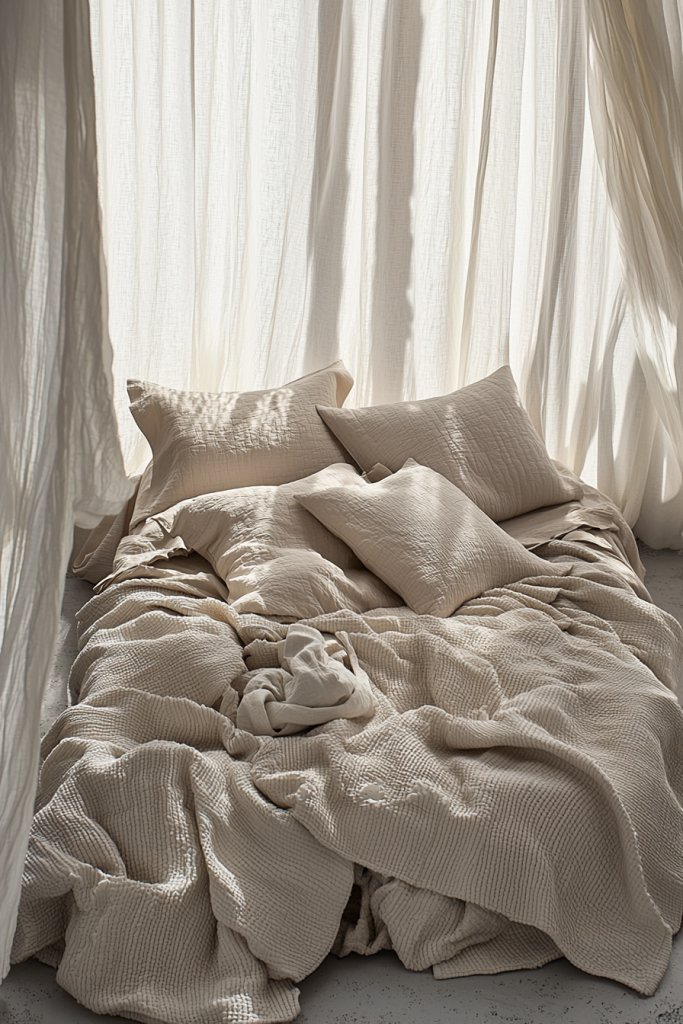
Transforming your bedroom into a serene retreat starts with bedding that invites both comfort and visual calm. Soft, textured bedding in gentle hues can elevate your space, making it feel warm and welcoming while maintaining the minimalist aesthetic of Japandi style.
Imagine a bed adorned with plush, linen sheets in muted taupe or soft beige, layered with a chunky knit throw in creamy ivory and a few matching textured cushions. The tactile contrast of smooth cotton or linen with the cozy, tactile surface of woven blankets creates a subtle depth that beckons you to relax.
The overall look is understated yet inviting, with calming earth tones and natural fabrics that evoke a sense of peace. When you step into this space, you’re greeted by a harmonious blend of softness and simplicity, where every touch and sight encourages tranquility.
Getting this look is simple and rewarding. Start with high-quality, soft bedding in neutral shades—think light grays, warm creams, or gentle browns—and add textured layers like a chunky knit throw or woven blankets.
Choose natural fabrics such as linen, cotton, or hemp for their breathable and tactile qualities. To complete the cozy feel, incorporate a few plush cushions in similar calm tones.
Layer these pieces on your bed, ensuring they’re arranged in a relaxed, slightly imperfect way to enhance the effortless Japandi vibe. With just a few thoughtfully selected textiles, you can create a sanctuary that’s both stylish and supremely comforting.
6. Sliding Shoji-Style Doors to Enhance Zen Vibes
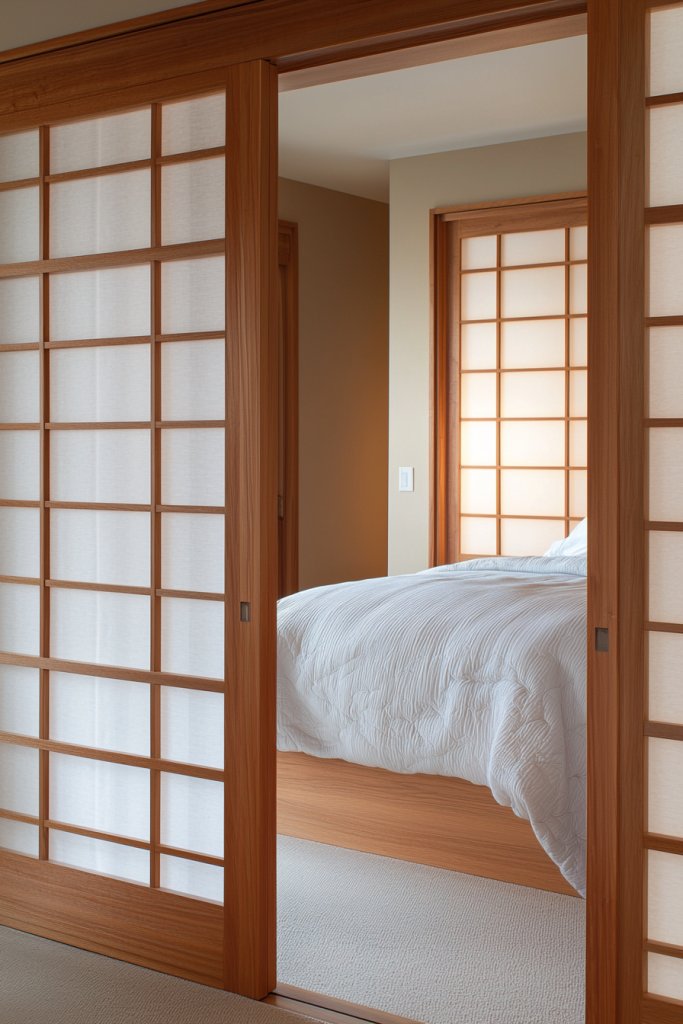
Sliding Shoji doors instantly transform a bedroom into a serene, Zen-inspired retreat, blending function with tranquil aesthetics. These doors, characterized by their lightweight wooden frames and delicate paper or fabric panels, create a seamless flow between spaces while maintaining privacy with a calming touch.
Their soft, muted tones and minimalistic design evoke a sense of quiet harmony, perfect for a Japandi bedroom. Imagine sliding doors with natural wood frames in warm oak or ash, featuring translucent white or cream panels that diffuse gentle light into the room.
As they glide smoothly open, they reveal a clutter-free space with clean lines, emphasizing simplicity and balance. The tactile experience of the smooth wood and soft panels adds a sensory layer, inviting calm and mindfulness.
Their understated elegance complements neutral palettes and minimal decor, making the room feel brighter and more expansive. To incorporate Shoji-style doors, start by measuring your doorway to ensure proper fit.
Choose lightweight, pre-made sliding door kits or DIY options with wooden frames and rice paper or fabric inserts. Install a sturdy track system at the top, ensuring it’s level for smooth operation.
For a more authentic look, opt for natural wood finishes, or paint the frames in muted tones to match your decor. Keep the overall design simple—pair with minimal hardware and avoid ornate details—to preserve the Zen vibe. With a little effort, these doors will create a calming, versatile space that invites relaxation.
7. Clutter-Free Nightstands with Sleek Storage Solutions
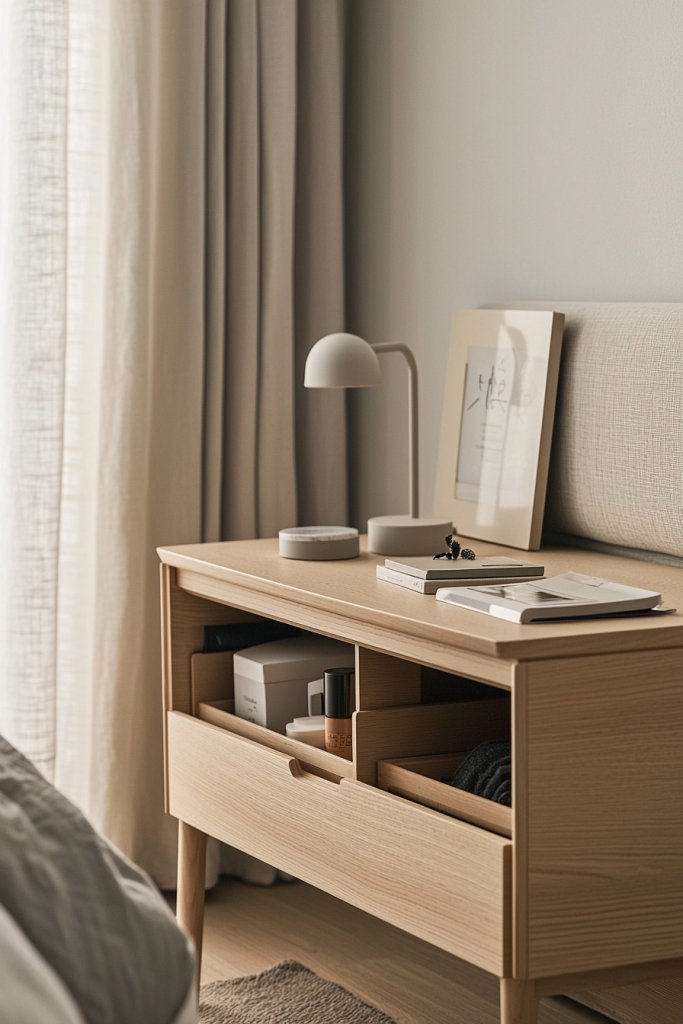
A sleek, clutter-free nightstand is essential in a Japandi bedroom to maintain its calming, organized atmosphere. These nightstands serve as a practical surface for essentials while hiding away unnecessary items, promoting a sense of order and tranquility.
Their streamlined design and minimalist storage options ensure the space remains visually clean and harmonious. Picture a small, rectangular wooden nightstand with a smooth surface in light oak or ash, featuring drawers or open shelving with simple, handleless fronts.
Inside, you might store books, a small ceramic clock, or skincare products, while the top hosts only a few carefully chosen decor pieces like a ceramic vase or a linen-covered lamp. The overall look feels light and airy, with smooth edges and neutral finishes that blend seamlessly into the room.
The absence of clutter allows your mind to relax and focus on the calming environment. To create this look, select a nightstand with clean lines—think floating or wall-mounted designs for an even more modern feel.
Opt for natural wood or matte painted finishes at a budget-friendly price. For storage, choose models with drawers or open shelves that help contain smaller items.
Keep surfaces clear by grouping essentials and regularly decluttering to sustain the minimalist aesthetic. This simple upgrade makes your nightly routine more peaceful and visually pleasing, reinforcing the Japandi principle of functional simplicity.
8. Simple, Geometric Lighting Fixtures for Subtle Elegance
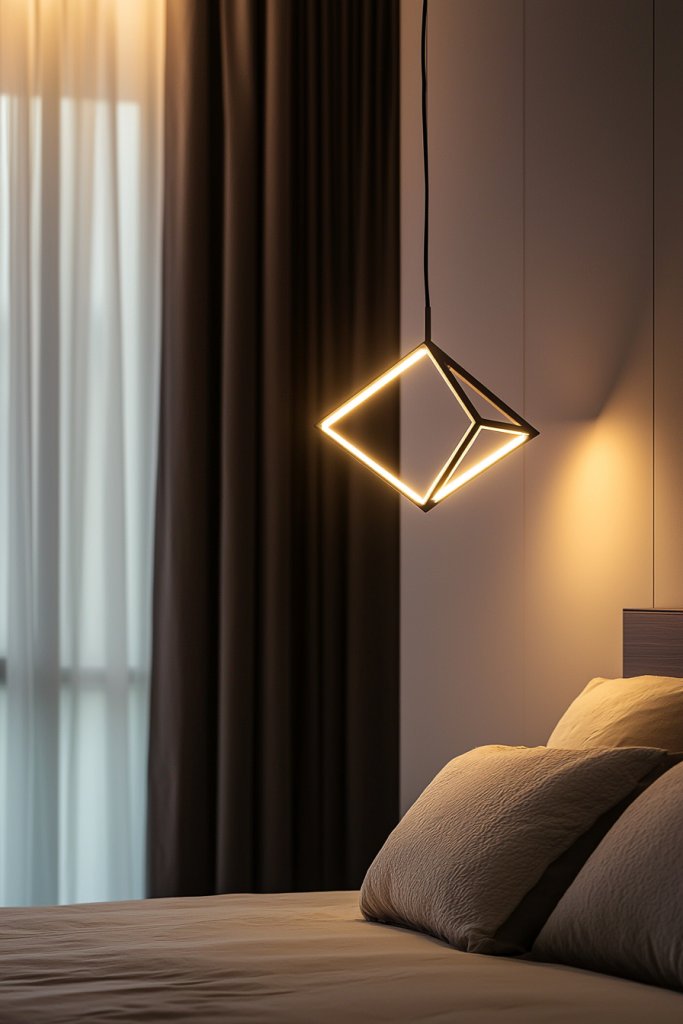
Lighting in a Japandi bedroom should be understated yet intentional, with geometric fixtures adding a touch of modern elegance. These fixtures serve as focal points that subtly elevate the room’s aesthetic, balancing soft ambient light with clean-lined design.
Their minimalist forms and neutral finishes seamlessly complement the calming, natural palette of the space. Envision a pendant light with a sleek black metal frame or a matte ceramic shade shaped into a simple geometric form—such as a sphere, cube, or cone—that hangs gracefully above the bed or beside it.
The light casts a warm, diffused glow that enhances the room’s tranquil atmosphere, while the geometric shape adds visual interest without overwhelming the space. The combination of soft lighting and sharp lines creates a refined, contemporary feel that’s both functional and beautiful.
To incorporate these fixtures, choose a minimalist pendant or wall sconce with a simple geometric shape—metal, ceramic, or wood finishes work well. Installation is straightforward, typically requiring a ceiling hook or wall bracket, and many options are suitable for DIY setup.
Pair with warm LED bulbs to create a cozy, inviting glow. Keep the overall design sparse and cohesive, avoiding overly ornate fixtures, to maintain the subtle elegance that defines Japandi style.
9. Layered Rugs in Neutral or Earthy Tones for Cozy Texture
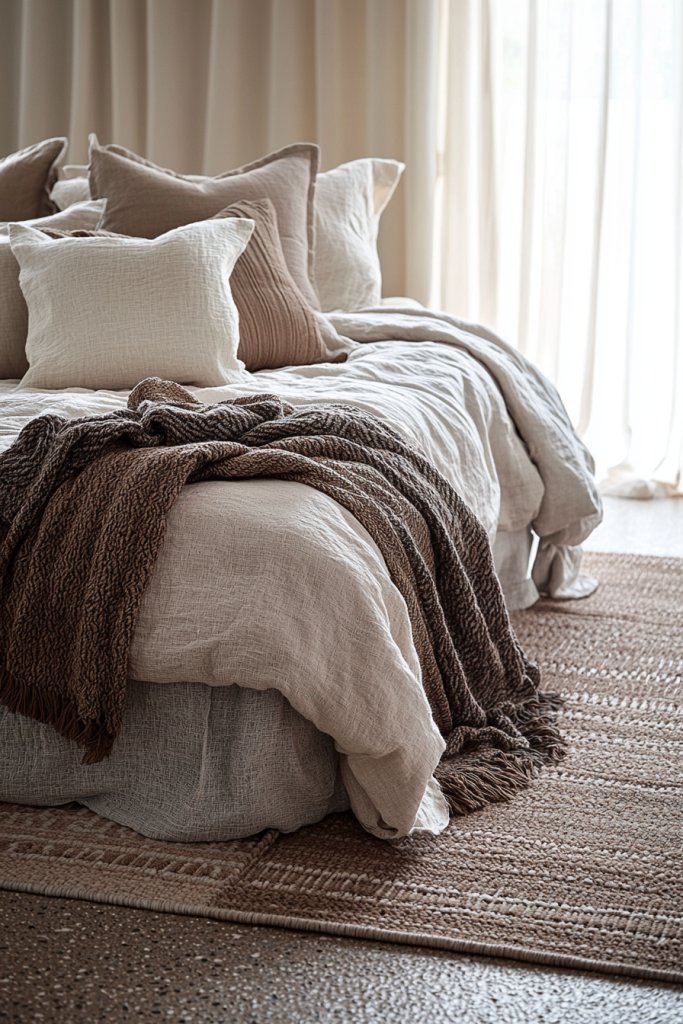
Adding layered rugs in neutral or earthy tones introduces warmth and tactile richness into a Japandi bedroom. These textiles create a cozy, inviting environment while enhancing the room’s visual depth and texture.
Their subtle patterns and natural fibers reinforce the minimalist aesthetic, making the space feel balanced and serene. Imagine a large, plush jute or wool rug in a soft beige or taupe, layered with a smaller, textured cotton or linen runner in muted greys or browns.
The combination offers a tactile contrast—smooth, rough, soft—that invites barefoot comfort and visual interest. The layered effect breaks up the floor space, anchoring furniture and creating a sense of coziness without clutter.
The natural fibers and muted hues evoke a calming, earthy vibe, perfect for a Japandi sanctuary. To implement, start with a neutral, large-scale rug as the base—think sisal, jute, or wool.
Add smaller, textured runners or mats with simple patterns or plain tones in complementary shades. Use non-slip rug pads underneath for safety and stability.
Choose materials like natural fibers or sustainable textiles to align with eco-conscious principles. This layered approach adds warmth and tactility, making your bedroom both stylish and irresistibly comfortable.
10. Incorporating Woven Baskets for Practical and Aesthetic Storage
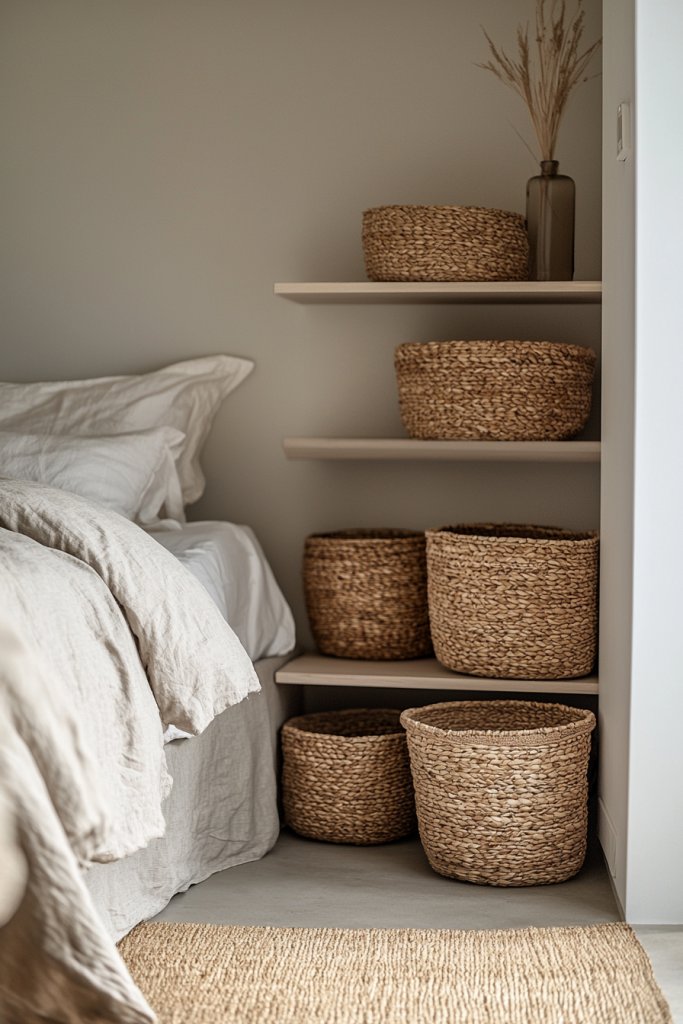
Woven baskets are both functional and decorative elements that fit perfectly into a Japandi bedroom’s ethos of simplicity and natural beauty. They provide versatile storage options for linens, books, or accessories while adding texture and warmth to the space.
Their handcrafted appearance enhances the room’s organic, cozy vibe without introducing visual clutter. Picture a set of medium-sized baskets woven from rattan or seagrass, placed under a low dresser or beside the bed.
Their neutral tones—beige, taupe, or natural brown—blend seamlessly with the room’s color palette, while their intricate woven patterns add subtle visual interest. Use them to store essentials out of sight but within easy reach, or as decorative containers for rolled-up throws or pillows.
The tactile quality of woven baskets adds depth and a handcrafted charm, enriching the minimalist aesthetic. To incorporate, choose baskets with sturdy handles for easy maneuverability, or opting for open-top designs for quick access.
They’re available in various sizes and natural finishes—consider sustainable options for eco-conscious choices. Place them strategically in your room, such as at the foot of the bed or in open shelving.
Regularly tidy and rotate items stored inside to maintain a clean, harmonious look. Woven baskets effortlessly combine practicality with aesthetic appeal, elevating your Japandi bedroom’s calm, organized charm.
11. Elegant Ceramic or Stone Vases as Decorative Accents
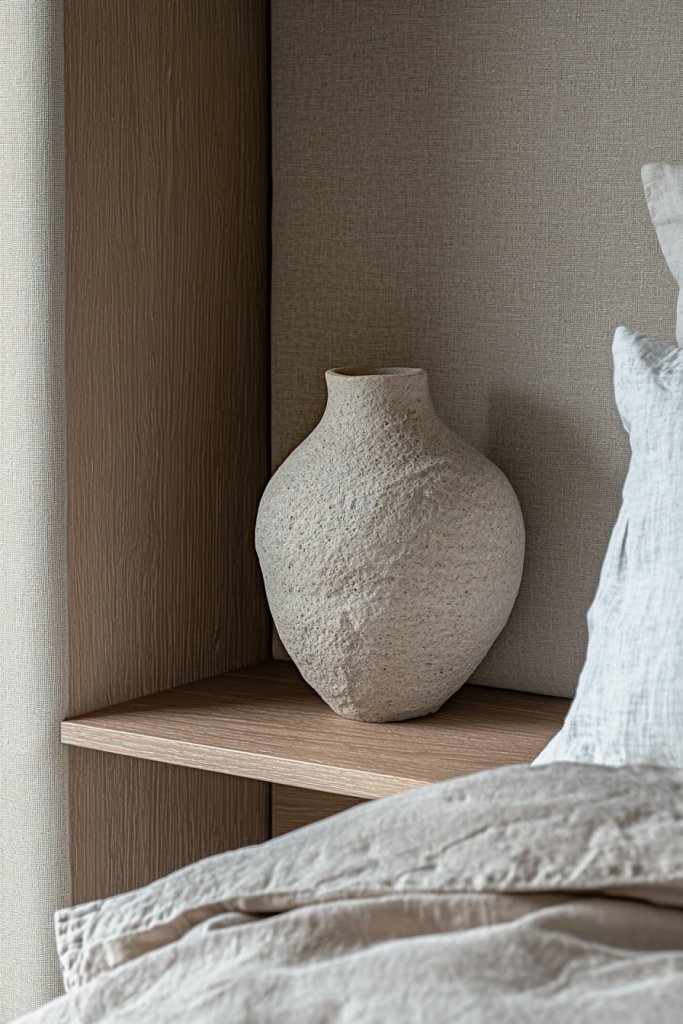
Adding ceramic or stone vases to your Japandi bedroom elevates the space with understated elegance and natural textures. These vessels serve as subtle focal points, bringing a sense of craftsmanship and organic beauty that complements the minimalist aesthetic.
Their smooth, matte finishes and muted tones blend seamlessly into the calm, neutral palette, creating a harmonious visual flow. Imagine a slender, tall ceramic vase in soft beige or a textured stone urn in cool gray, placed on a simple bedside table or shelf.
The surface might feature gentle ridges or a matte glaze that catches the light softly, adding tactile interest. These vases can hold single dried branches, minimalist floral arrangements, or stand alone as sculptural decor, enhancing the room’s Zen-inspired vibe through their natural, unpretentious charm.
The overall effect is a space that feels both curated and effortlessly serene. To incorporate these accents, start with a clean-lined ceramic or stone vase from a home goods store or artisan market.
Choose shapes and sizes that complement your room’s proportions—tall and slender for narrow spaces, or rounded for a cozy corner. Fill them with natural elements like dried grasses or minimalist botanicals, or leave them empty to emphasize their sculptural quality. Keep the color palette neutral to maintain the calm, balanced atmosphere typical of Japandi design, and place these vases thoughtfully on surfaces or open shelving for maximum visual impact.
12. Modular Shelving with Open Storage for a Clean Look
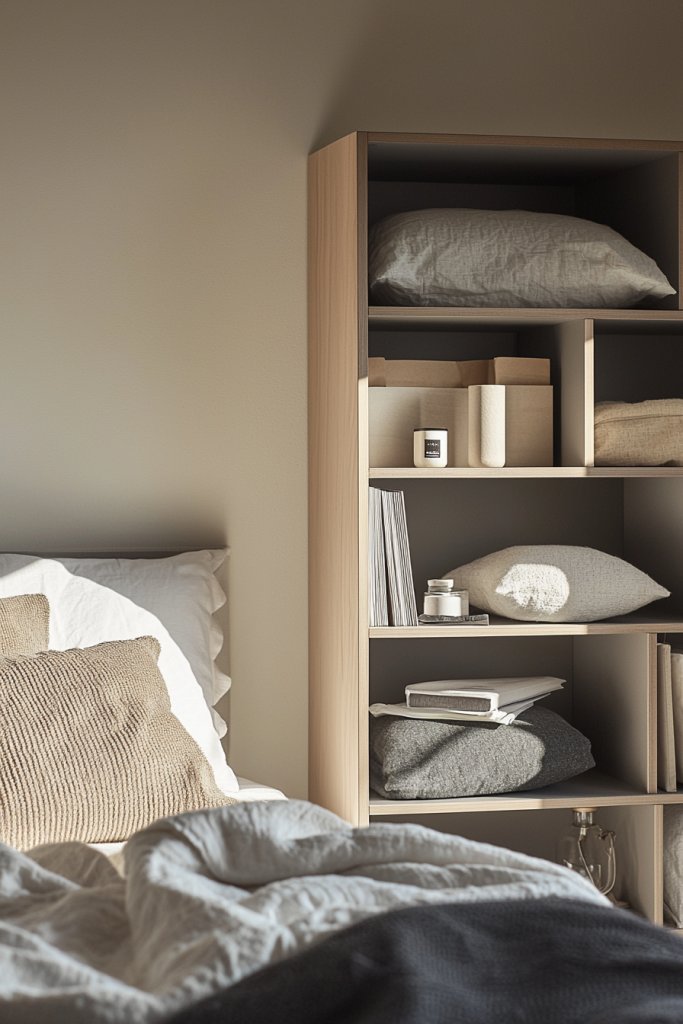
Modular shelving systems are a perfect way to keep a Japandi bedroom organized while maintaining a sleek, unobtrusive aesthetic. These open storage units emphasize simplicity and flexibility, allowing you to display essentials and decorative objects without clutter.
Their clean lines and neutral finishes foster a sense of calm and order, key to achieving the Japandi balance. Picture a low-profile, wooden modular shelf with a natural or matte black finish, divided into open cubbies or minimalist compartments.
You might arrange woven baskets, neatly folded textiles, or curated decorative objects like ceramics or sculptures within. The open design encourages visual breathing space, preventing the room from feeling crowded, and makes it easy to access items daily.
The arrangement fosters a sense of serenity, with everything visible yet intentionally kept tidy. To implement this, choose a modular shelving system made of light wood or metal with a simple, geometric design.
Start with a basic configuration and add or rearrange components over time as your needs evolve. Use open baskets or trays made of natural fibers like rattan or linen to conceal clutter without sacrificing the open look.
Keep the color palette neutral—think beiges, greys, or black—to reinforce the tranquil vibe. Position the shelving against a wall or under a window to maximize space and create a visually calming focal point that complements your minimalist Japandi decor.
13. Using Soft curtains or blinds in muted shades for Privacy and Calm
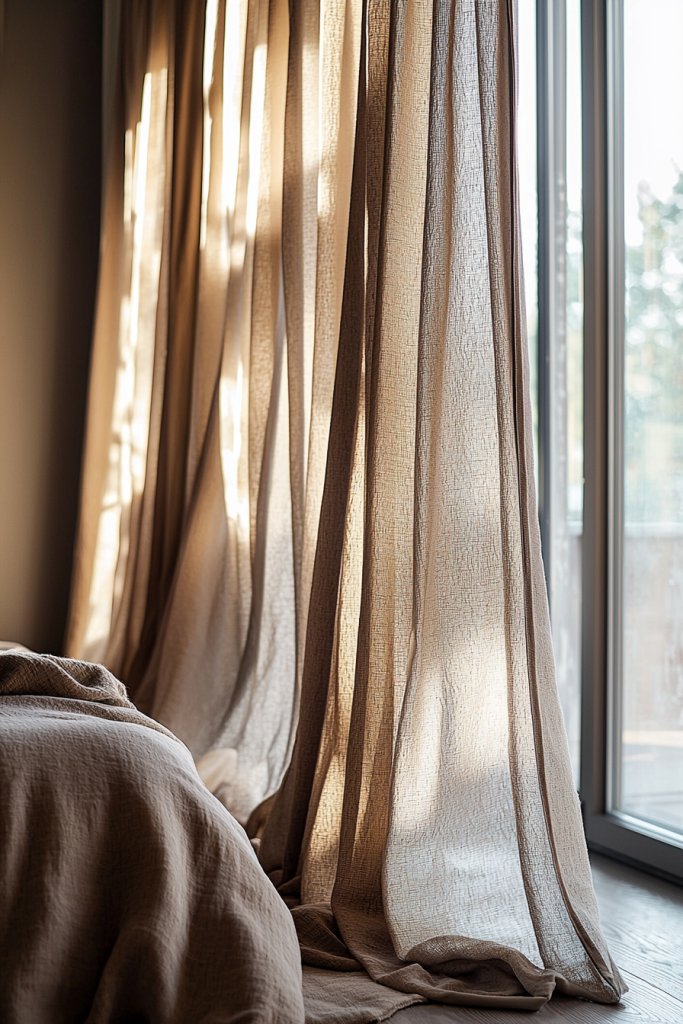
Soft curtains or blinds in muted, earthy tones are essential for creating a tranquil, private sanctuary in a Japandi bedroom. They gently filter natural light, casting a warm, diffused glow that enhances the room’s calm atmosphere.
Their understated fabrics and simple designs prevent visual noise, maintaining the clean, minimalist aesthetic. Visualize sheer linen curtains in warm beige or muted taupe, delicately draping from a simple rod, softly fluttering with the breeze.
Alternatively, smooth roller blinds in a matte, neutral shade can be drawn down for privacy without adding visual clutter. Both options create a sense of softness and serenity, while their fabric textures subtly contrast with the room’s hard surfaces, adding tactile comfort.
These window treatments also help control light levels, making the space feel cozy and inviting at any time of day. To incorporate, select curtains made from natural fabrics like linen or cotton, which add a tactile layer of comfort.
For blinds, opt for styles in matte finishes that coordinate with your overall color scheme. Mount the hardware minimally to avoid distraction and keep the focus on the soft, flowing fabric.
Keep the shades in gentle, muted tones—such as warm gray, soft cream, or stone—to seamlessly blend with your room’s neutral palette. This simple addition enhances privacy and tranquility, making your Japandi bedroom a true retreat from the busy world outside.
14. Incorporating Sculptural Elements in Furniture or Decor
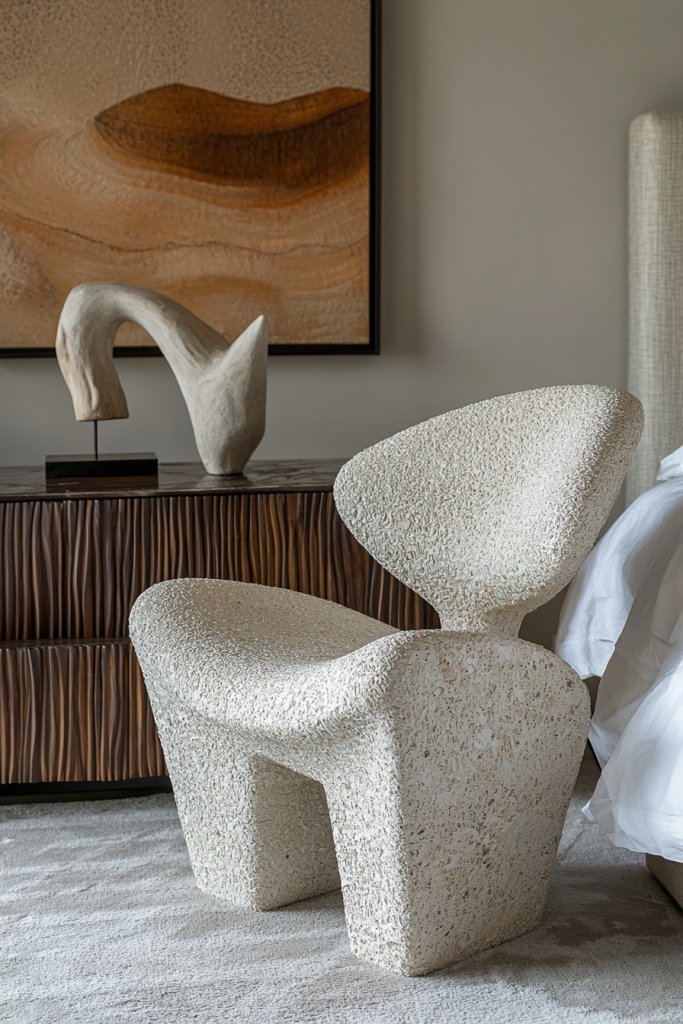
Sculptural decor elements introduce an artistic, tactile dimension to a Japandi bedroom, balancing functionality with aesthetic sophistication. These pieces serve as statement accents that add visual interest and a sense of curated elegance, while still aligning with the room’s minimalist principles.
Imagine a smooth, abstract ceramic sculpture placed on a side table or shelf, or a contemporary stone or wood sculpture with clean, geometric lines. These objects might feature rounded, organic forms or sharp, angular shapes that evoke a sense of calm and balance.
Their materials—natural stone, matte ceramics, or unfinished wood—bring texture and depth, subtly contrasting with the room’s soft textiles and sleek surfaces. These sculptural elements act as focal points, guiding the eye and creating a sense of harmony and intentionality in the space.
To incorporate, look for simple, handcrafted sculptures that resonate with your aesthetic—either from local artisans or online shops. Place them thoughtfully on surfaces like bedside tables, shelves, or window sills, ensuring they don’t overwhelm the space.
Opt for neutral tones such as stone gray, soft beige, or black to maintain visual cohesion. These elements should feel purposeful yet unobtrusive, adding a layer of artistic refinement that elevates the overall calm and balanced vibe typical of Japandi design.
15. Monochrome or Limited-Color Bedding Sets for Visual Cohesion
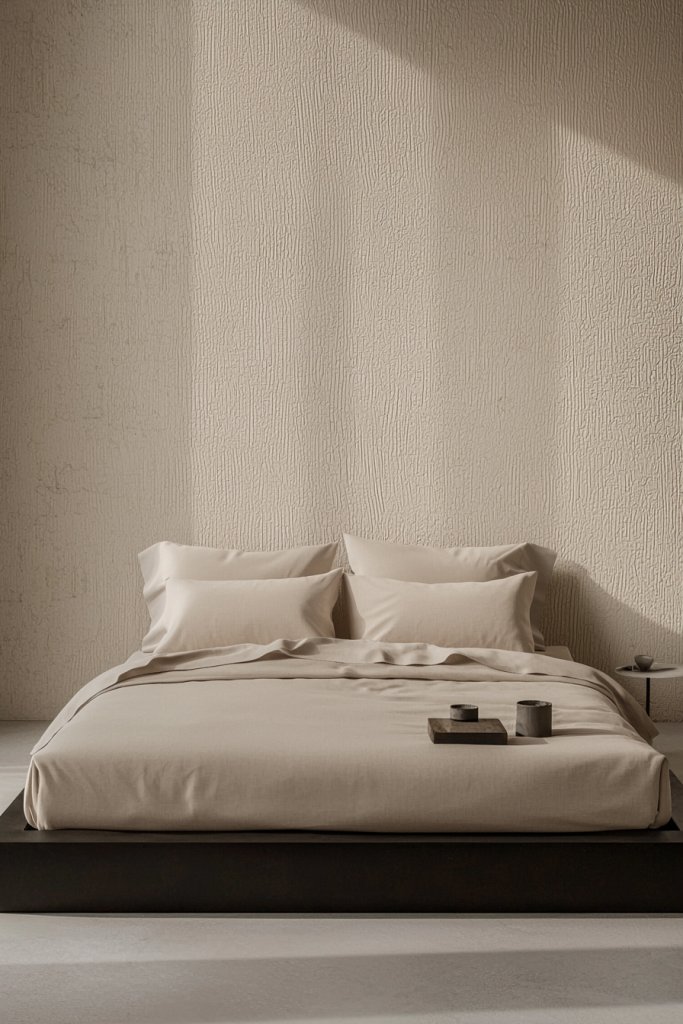
Choosing monochrome or limited-color bedding sets is a simple yet powerful way to create a cohesive, calming environment in a Japandi bedroom. This approach minimizes visual clutter, emphasizing serenity and uniformity, which are key to the aesthetic’s focus on balance and harmony.
Picture a soft, cream-colored duvet cover paired with matching pillowcases in a slightly darker shade, or a muted taupe set that complements the room’s neutral palette. The fabrics are textured—perhaps a linen blend or cotton with a subtle weave—to add tactile interest without overwhelming the senses.
Keeping the color palette limited ensures that all elements work together seamlessly, allowing the textures and subtle variations in tone to stand out. This consistency fosters a peaceful atmosphere, making the space feel thoughtfully curated and relaxing.
For implementation, select bedding in neutral shades like beige, gray, or soft white—preferably in natural fabrics such as linen, cotton, or hemp—that evoke warmth and simplicity. Stick to solid colors or very subtle patterns to keep the look clean and uncluttered.
Layer the bedding with textured throws or pillows in matching tones to add depth and comfort. Maintaining this monochrome or limited palette creates a visually cohesive sanctuary that encourages rest and reflection, embodying the peaceful spirit of Japandi design.
16. Floating Nightstands for a Lightweight, Modern Feel
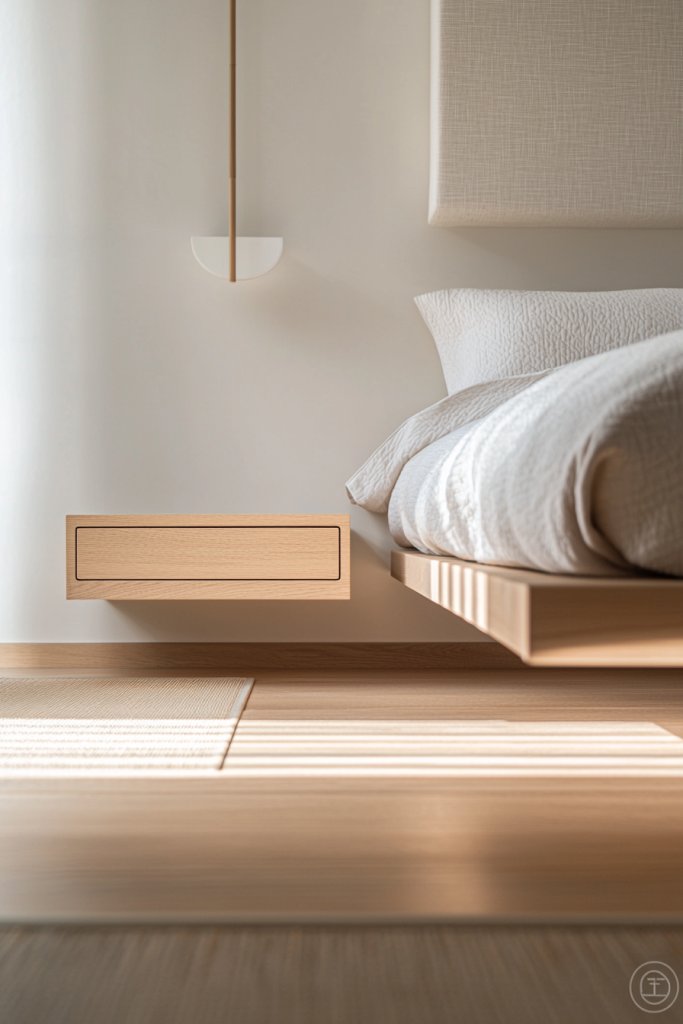
Creating a sense of openness and sleekness, floating nightstands are a popular choice in Japandi bedrooms. They appear to hover effortlessly beside your bed, eliminating visual clutter and making the space feel larger.
This design choice emphasizes clean lines and minimalism, key elements of Japandi style, while providing practical surface space for essentials. Imagine a narrow, rectangular wooden shelf mounted seamlessly to the wall, finished in a soft matte stain like light oak or ash.
The surface is smooth, with enough room for a small ceramic lamp, a few books, or a simple vase. The space beneath is unobstructed, which enhances the feeling of lightness and airiness.
The overall look is calm and uncluttered, with the floating effect drawing your eye upward and emphasizing the room’s spaciousness. Soft, warm lighting from the lamp adds a cozy glow, making the space inviting and tranquil.
To implement this idea, start by selecting a sturdy, slim wooden plank or a pre-made floating shelf in a neutral tone—think light wood or matte black for contrast. Mount it securely at your desired height, using wall anchors for stability.
For a beginner-friendly approach, opt for a floating shelf kit that includes all necessary hardware and detailed instructions. Keep the design simple by avoiding bulky or ornate pieces, and ensure the placement complements your bed’s proportions for a balanced look.
17. Integrating Storage Ottomans for Functionality and Style
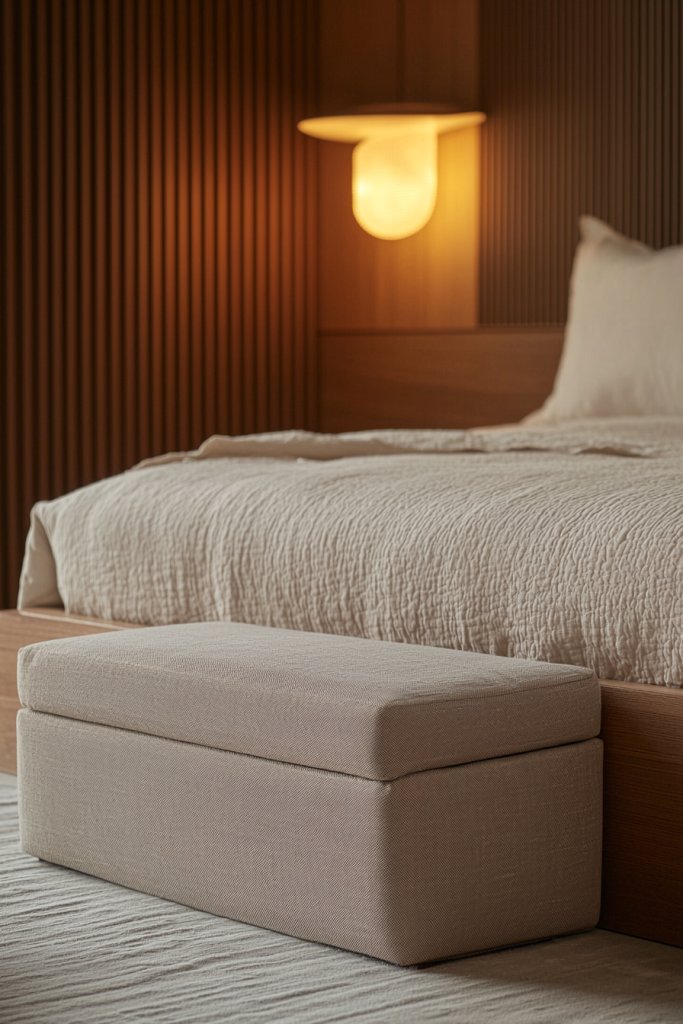
Storage ottomans are a versatile addition to a Japandi bedroom, combining practicality with understated elegance. They serve as seating, footrests, or even side tables, while discreetly hiding away clutter like extra bedding or seasonal clothing.
Their minimalist design aligns perfectly with the clean, functional aesthetic of Japandi style. Picture a low-profile, rectangular ottoman upholstered in natural linen or soft cotton in muted shades such as taupe, beige, or warm gray.
The top is plush yet sleek, inviting you to sit or rest your feet, while the interior offers spacious storage for keeping the room tidy. The exterior features simple, unadorned stitching or subtle piping, emphasizing craftsmanship and natural materials.
The understated look complements wooden furniture and textured textiles, adding warmth and layering to the space. To incorporate a storage ottoman, measure your available space and choose a size that fits comfortably without overcrowding.
Opt for a model with a hinged lid for easy access, and look for options with natural fiber upholstery or sustainably sourced wood legs. For a budget-friendly alternative, repurpose a sturdy cardboard or wooden crate with a cushion on top. Placing the ottoman at the foot of your bed creates a cozy, functional focal point that enhances your room’s calm and organized vibe.
18. Subtle Textured Wall Treatments or Wallpapers for Depth
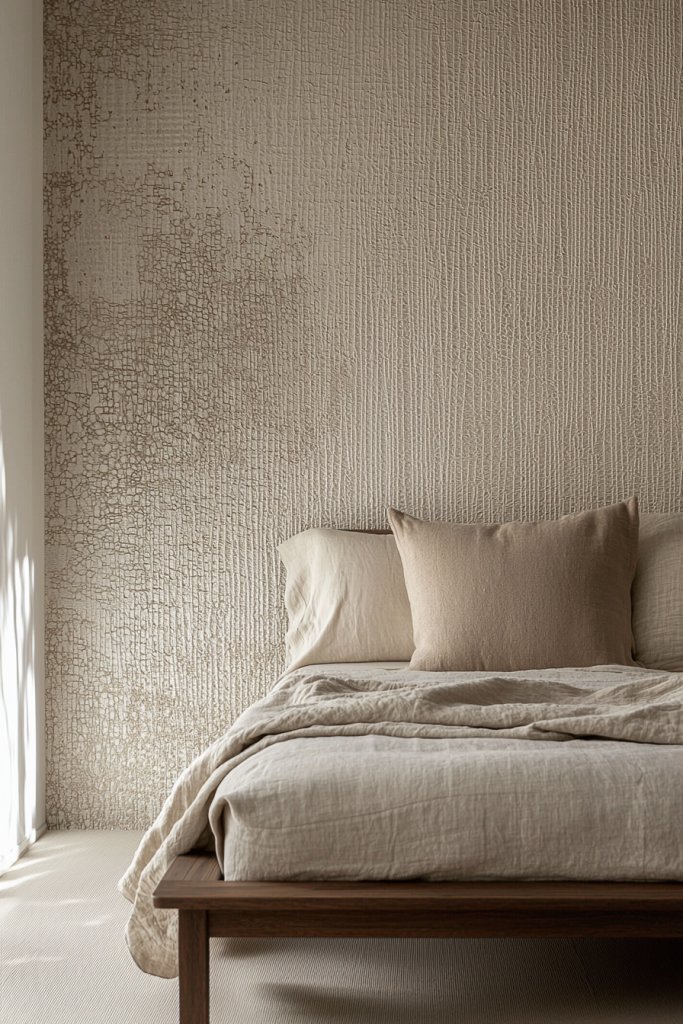
Adding subtle texture to your bedroom walls can dramatically increase visual interest without disrupting the minimalist aesthetic. Textured wall treatments or wallpapers create depth and dimension, making a simple space feel layered and sophisticated—an essential aspect of Japandi design.
Visualize a soft, tactile wall finished with a linen or woven fabric wallpaper in neutral tones like warm beige or light ash. Alternatively, a gentle plaster or stucco technique applied with a trowel gives the wall a matte, stone-like appearance that adds organic texture.
These treatments absorb light softly, creating gentle shadows and a sense of depth that invites calm and reflection. Keep the design understated; avoid busy patterns or vibrant colors to maintain the room’s tranquil, cohesive atmosphere.
To achieve this look, choose wallpaper with a subtle textured finish or opt for a DIY plaster technique if you’re confident in your skills. For easier application, select peel-and-stick textured wallpaper in a neutral hue, which is removable and low-mess.
Prepare your wall by cleaning and priming it, then follow the manufacturer’s instructions carefully. The result is a beautifully understated backdrop that enhances the room’s natural materials and minimalist palette, adding warmth and tactility to your Japandi sanctuary.
19. Incorporating Natural Stone or Concrete Elements for an Earthy Touch
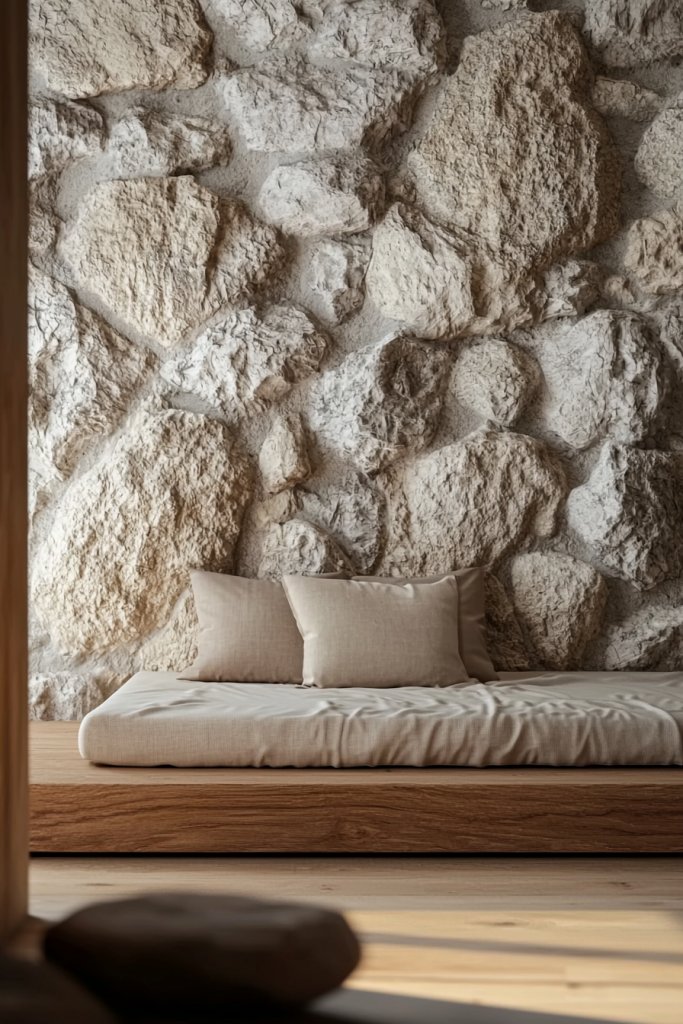
Integrating natural stone or concrete elements introduces an earthy, grounding quality characteristic of Japandi interiors. These materials evoke a sense of permanence and connection to nature, enriching the room with texture and subtle variation.
Whether used as accents or functional components, they elevate the overall calm aesthetic. Picture a minimalist concrete bedside table with a smooth, matte finish or a natural stone vessel for holding small decor items.
These elements often feature raw, unpolished edges or subtle veining, adding organic visual interest. The cool, tactile surfaces contrast beautifully with warm wood furniture and soft textiles, creating a balanced, harmonious environment.
The muted palette of greys, taupes, and beiges further enhances the tranquil, earthy vibe. To incorporate these materials, look for pre-made concrete or stone pieces such as lamps, planters, or side tables from sustainable brands or local artisans.
For DIY enthusiasts, small projects like casting your own concrete trays or candleholders are accessible with basic supplies. Ensure the pieces are sealed or treated if necessary for durability, and pair them with natural fiber textiles to soften the overall look. These elements anchor the space, making it feel rooted and serene, perfectly aligned with Japandi principles.
20. Strategic Use of Negative Space to Maintain Balance
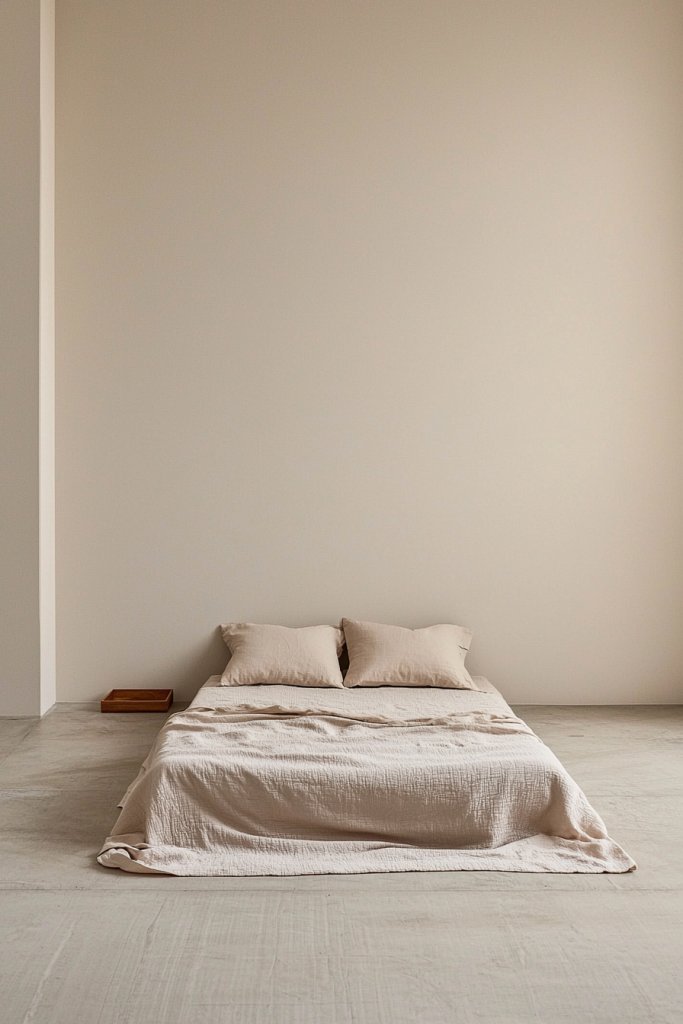
Mastering negative space—the areas intentionally left unfilled—is crucial in achieving the calm, balanced aesthetic of Japandi bedrooms. It emphasizes simplicity and allows each element to breathe, preventing visual clutter and promoting mental clarity.
Think of a room with a carefully curated few decor pieces: a single ceramic vase, a textured throw blanket, and a small sculpture, all arranged with generous gaps between them. This approach creates a sense of order and tranquility, guiding the eye naturally across the space without overwhelming it.
The open areas act as visual pauses, making the room feel more spacious and peaceful. Use this principle to highlight key design features and avoid overcrowding, ensuring every piece has room to stand out.
To implement this, start by decluttering and selecting only essential decor items. Place larger furniture pieces with ample space around them, and arrange accessories with intentional gaps.
Incorporate open shelving or wall-mounted storage to keep surfaces clear. Maintaining balance is about restraint—choose a few meaningful objects and give them room to be appreciated. This mindful use of negative space fosters a serene environment that embodies the calm and simplicity of Japandi design.
21. Decorative Japanese-Inspired Screen Partitions for Flexibility
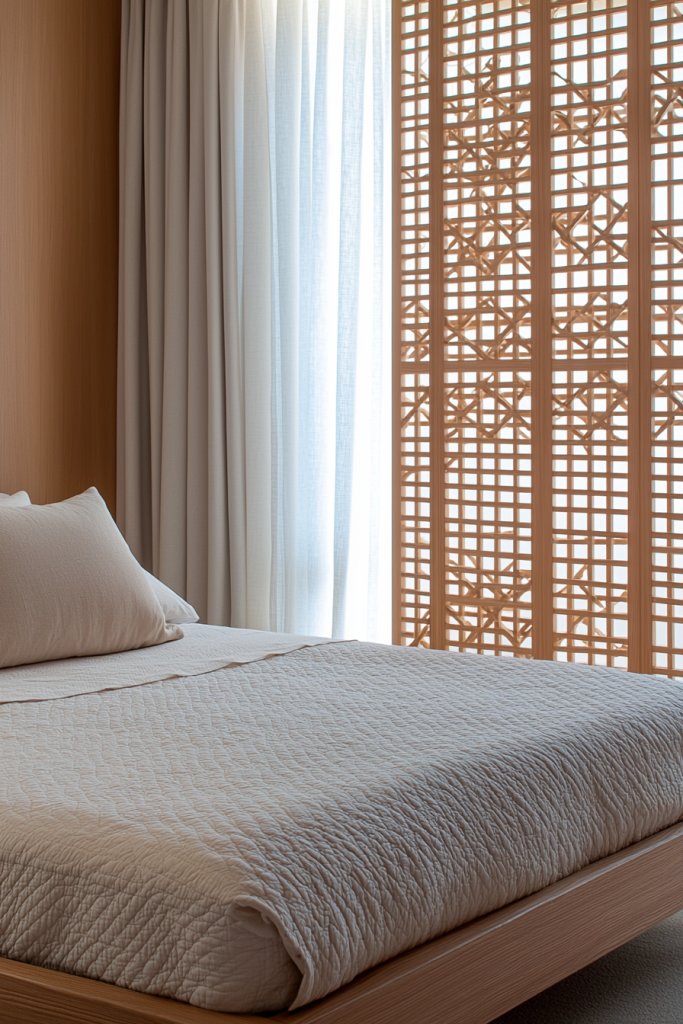
Adding Japanese-inspired screen partitions to your bedroom introduces a versatile element that enhances privacy, defines space, and adds a touch of elegance. These screens are not only functional but also serve as beautiful design features that evoke the calm and simplicity of Japandi style.
Their presence can transform an open layout into cozy, intimate zones while maintaining the minimalist aesthetic. Picture a delicate, folding screen crafted from light, natural wood frames with rice paper or linen panels.
The screens feature subtle, geometric patterns or plain surfaces in muted tones like soft beige, warm taupe, or charcoal gray, blending seamlessly into the room. When in place, they create a soft glow of filtered light and a sense of layered depth, while their lightweight structure allows for easy repositioning.
The overall effect is a tranquil, adaptable space that feels both open and secluded. Recreating this look is straightforward.
Start by choosing a set of folding screens made from bamboo, light wood, or metal frames with fabric or paper panels—these are widely available online or at home decor stores. For a DIY approach, you can build your own with simple wooden slats and rice paper or linen fabric.
Position the screens to partition your bedroom into different zones or to hide clutter behind them. Keep the design minimal by sticking to neutral hues and simple patterns, and ensure they’re lightweight enough to move easily when needed.
22. Incorporating Soft, Ambient Lighting for a Calm Glow
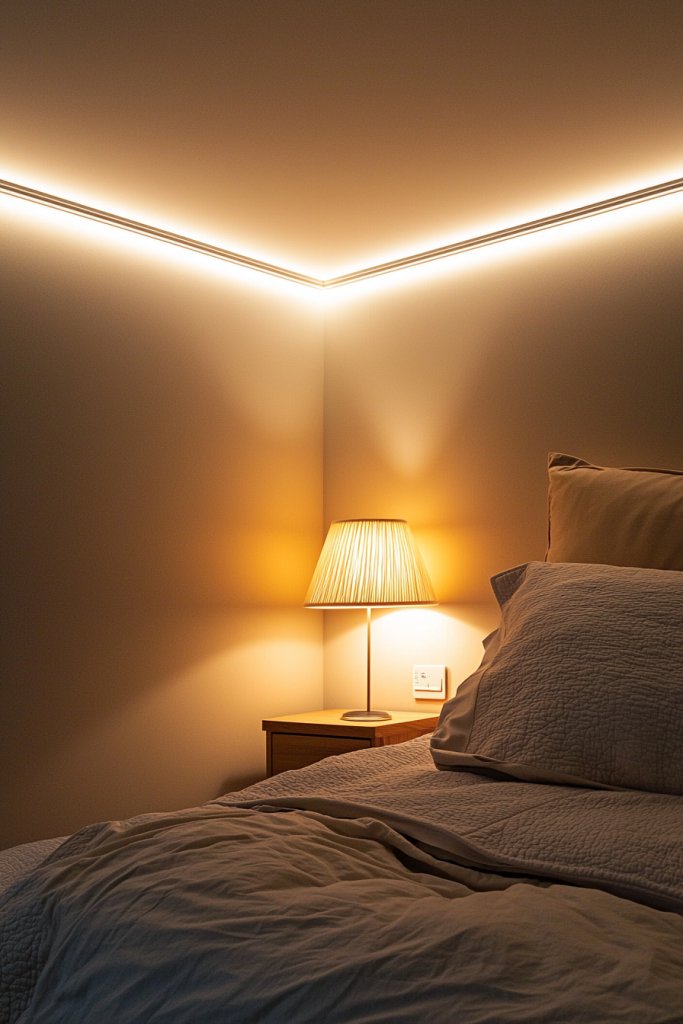
Soft, ambient lighting is key to creating a calming and inviting Japandi bedroom. Gentle illumination transforms the space into a sanctuary, reducing harsh shadows and fostering relaxation at any time of day or night.
The right lighting emphasizes the room’s natural textures and understated elegance, making it feel warm and balanced. Imagine a room softly illuminated by a combination of warm LED strip lights hidden behind crown molding, table lamps with linen shades, and small, frosted pendant fixtures.
The lighting casts a gentle, diffuse glow that accentuates the neutral color palette and textured surfaces like woven throws or ceramic vases. The overall atmosphere is serene, almost like a cozy cocoon, inviting you to unwind.
The subtle light also minimizes glare and creates a peaceful environment conducive to rest. To achieve this, start with warm white LED bulbs (around 2700K) for a natural, cozy feel.
Incorporate dimmable fixtures to adjust brightness according to mood or time of day. Use table lamps with soft fabric shades on nightstands and consider adding hidden LED strips behind crown moldings or under bed frames for indirect lighting. Keep the setup simple and avoid overly bright or colorful lights, focusing instead on layers that gently fill the room with a calming, harmonious glow.
Conclusion
With a diverse array of ideas—from minimalist furniture and neutral palettes to textured accents and subtle lighting—this collection showcases how to craft a Japandi bedroom that exudes calm and balance. By blending natural materials, clean lines, and thoughtful organization, you can transform your space into a serene retreat.
Embrace these inspiring concepts and let your bedroom become a harmonious sanctuary that reflects simplicity and tranquility. Start your journey toward a more peaceful, balanced environment today.
Leave a Reply